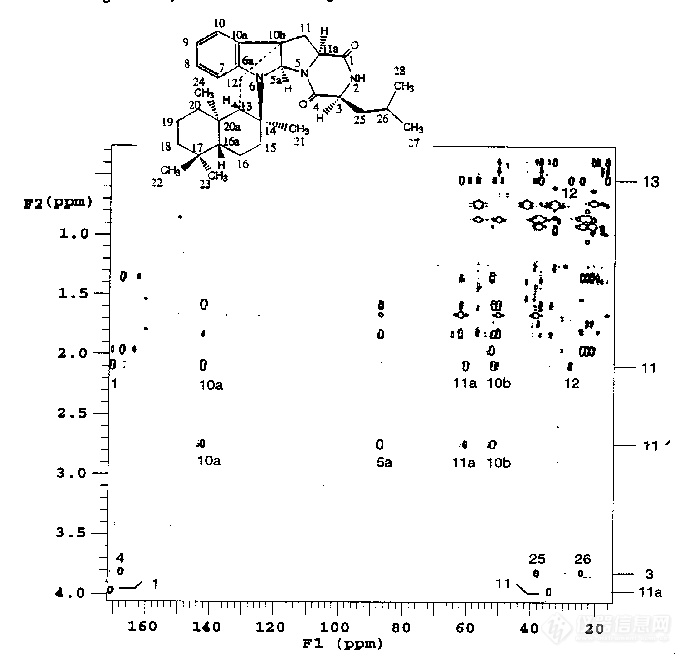HMBC
Introduction:
Heteronuclear Multiple Bond Correlation is an experiment that identifies proton nuclei with carbon nuclei that are separated by more than one bond. The pulse sequence utilizes zero and double quantum coherence between J-coupled protons and carbons to label each proton with the frequency of a remote carbon in the F1 dimension of a two dimensional experiment. The experiment is closely related to HMQC and uses the same principles to convert transverse magnetization into zero and double quantum coherence with the exception that the delay is matched to the inverse of the long range coupling constant nJCH and there is a filter to suppress crosspeaks arising from one-bond proton-carbon interactions. The one-bond filter has a delay that is matched to the inverse of 1JCH. In the pulse sequence that is currently implemented, the one-bond filter is optimized by entering an average 1JCH, usually 14O Hz, but if there are no aromatic or alkene groups, then 125 Hz may be a better choice. The delay corresponding to the multiple bond J coupling nJCH (taumb) is entered directly in seconds (a good first choice is O.04 sec , but if the long range couplings are small then O.O6 sec is optimum).
HMBC is the equivalent of LRHETCOR, but because it is a proton-detected experiment, HMBC is more sensitive than LRHETCOR. Major applications include the assignment of resonances of non-protonated carbon and nitrogen nuclei and the long range correlation of protonated carbon resonances that are separated by non-protonated carbons and other heteronuclei. The intensity of the crosspeaks generated by this experiment is related to the size of the multiple bond J coupling constant, nJCH, and the choice of the delay, taumb. There is no simple relationship between the size of nJCH and the number of intervening bonds which means that careful analysis of the spectrum in combination with other data is required. One common example of this problem is observed in some aromatic systems. 2JCH is so small that a crosspeak may not be observed but 3JCH is large resulting in an intense crosspeak.
The Problem:
Identify all the non-protonated carbon resonances that are 2, 3 and 4 bonds distant from the protons H11 and H11a. Find the nearest protonated carbon resonances to the geminal H11 protons in drimentine D.
Results:
The spectrum below demonstrates several aspects of HMBC. Firstly, not all 2,3 and 4 bond correlations are observed. H11a has crosspeaks with only two carbon resonances (C1 and C11) and both of these are two bonds away. Secondly, the crosspeak patterns for the geminal H11 protons are not identical. The resonance at 2.7 ppm has crosspeaks with C10b, C11a (2JCH) and C1Oa, C5a (3JCH) whereas the resonance at 2.1 ppm has crosspeaks with C10b, C11a (2JCH) and C1, C12 (3JCH). These resonances do not have any 4 bond correlations but in the initial stages of the assignment this possibility must be considered. Thirdly, the crosspeak for C12 is also seen at the H13 resonance demonstrating that the H11-H11a fragment adjoins the C12-C13 fragment.
Selected proton resonances are labelled at the side of the spectrum and selected carbon resonances are labelled beside the crosspeak.
![]()

